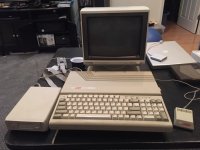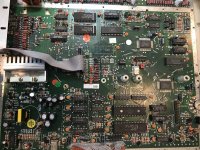OleLila
Well-known member
I had a working Laser 128 ex ((Apple IIc clone) that was working fine. The external 3.5 inch drive was not, but I could plug it into the computer and just get an I/O error on APTPro. I disassembled the external drive, unplugging multiple small connections in the process, cleaned, reassembled. The e external drive spun the first time, but no disk recognition. The second time....nothing, no noise, no smoke, no pops....Power LED on computer is on but nothing else, no internal drive noise, no reset with keyboard.
The voltages on the external drive connections are fine. I can use a voltmeter but that’s about it. I cannot find board diagrams for the Laser 128 to even try and give it a shot. Any advice on where to start?
The voltages on the external drive connections are fine. I can use a voltmeter but that’s about it. I cannot find board diagrams for the Laser 128 to even try and give it a shot. Any advice on where to start?




